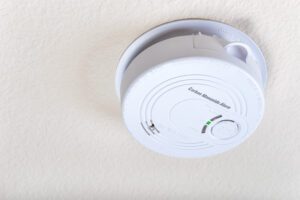Your Golf Cart Charger & Your Carbon Monoxide Detector: The 1 Frightening Truth

Most golf carts are powered by lead-acid batteries, renowned for their high surge currents and relatively low price. Lead-acid batteries are reliable and very inexpensive on a cost-per-watt basis. If you own a golf cart, there is a good chance that your carbon monoxide detector has tripped while charging your golf cart in your garage. What exactly causes this? In order to explain why, we need a basic understanding of how lead-acid batteries work chemically.
How Do Lead-Acid Batteries Work?
A lead-acid battery uses a chemical reaction between lead and a solution of sulfuric acid to store energy. The solution of sulfuric acid and distilled water acts as an electrolyte, allowing the flow of electric charge between the lead plates through the distilled water medium.
Discharging Process:
powers your golf cart.
Charging Process:
Overcharging:
whereby an electric current passes through a substance to cause a chemical change. In the case of distilled water in your batteries, electrolysis breaks water down into its component elements, which are hydrogen and oxygen gases. These gases then escape from the battery, which is why sometimes you hear bubbling or see bubbles coming from a battery that's being charged – that is the hydrogen and oxygen gas being created and escaping.
So Why Does My Carbon Monoxide Detector Go Off When I Charge My Lead-Acid Batteries?
Golf cart owners often ask this question. Charging these batteries can trigger a carbon monoxide detector, even though lead-acid batteries do not generate carbon monoxide. The cause lies in the gases produced by the battery's chemical processes, particularly when overcharged. Many modern carbon monoxide detectors detect carbon monoxide and other dangerous gases such as hydrogen. This is what actually triggers the alarm.
What Causes Overcharging?
Older Batteries
As a battery pack ages, the condition of the individual batteries varies. Therefore, the capacity of the individual batteries varies. Since the batteries are connected in series, your charger distributes power evenly to all the batteries. During the charging cycle, weaker batteries with reduced capacity will charge faster than healthier ones. This can cause the weaker batteries to overcharge before the remaining batteries reach a full charge.
Defective Battery Charger
When your battery charger operates correctly, it follows instructions from a charge algorithm, which progresses through several stages during the charging process: Bulk Charge, Absorption Charge, and Float Charge. Each stage has different parameters for frequency, voltage, and amperage. Your battery charger might not transition correctly between these stages if it malfunctions. For example, if the charger fails to switch from the bulk charge phase to the absorption phase when the battery voltage reaches the specified limit, it will continue providing a constant high current. This results in overcharging. It's worth noting that some modern battery chargers have built-in safeguards to prevent overcharging, including temperature sensors and timers. However, if these components become defective, overcharging can still occur.
Incorrect Charge Algorithm
Similarly, even if your battery charger is in perfect working order, overcharging can occur if the batteries installed in your golf cart and not paired with the appropriate charge algorithm. For instance, Trojan T875 batteries use a different charge algorithm than a US8VGCXC even though they are both lead-acid deep cycle batteries with the same capacity. If your charger is programmed with the Trojan algorithm, it will overcharge the US Batteries installed in your golf cart.
How to Prevent Overcharging
Understanding the potential dangers and adopting safe practices when charging lead-acid batteries is key. Here are some precautions:
- Ensure Proper Ventilation: Always charge your batteries in a well-ventilated area to avoid gas accumulation.
- Use the Correct Charger: Use a high-quality battery charger programmed with the correct charge algorithm for your specific batteries.
- Perform Regular Maintenance: Regularly check your batteries for damage or wear and ensure the water level is correct. Therefore, it's crucial to regularly check all batteries in your system, replacing any that aren't working properly.
- Check Specific Gravity: Use a Hydrometer to compare the specific gravity readings across different cells of a given battery. In a perfectly healthy battery, all cells should have similar specific gravity readings when fully charged. However, if there is a noticeable disparity between the specific gravity readings of the cells, it might signify a weak or failing cell. A lower specific gravity in a cell indicates a lower concentration of sulfuric acid, which implies a lower state of charge.
- Upgrade Your Batteries: Consider upgrading to AGM or lithium batteries if you have concerns about charging lead-acid batteries in your garage.
Final Thoughts
Click here to learn more about batteries!
